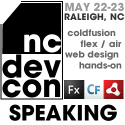I've mentioned previously that Mark Mandel, the mastermind behind Transfer ORM, JavaLoader, ColdDoc, and now the lead developer of Coldspring, and I have developed an intensive, two-day, hands-on workshop on ColdFusion's new ORM features. We will be delivering that workshop, Developing Applications with ColdFusion 9 Object Relational Mapping, in Minneapolis, MN on April 20-21, 2010 which are the two days immediately preceding the cf.Objective() conference.
Really? I Can Master ColdFusion ORM in Two Days?
You bet you can! This is an extreme hands-on workshop. We won't be lecturing at you, we'll be working with you. For each concept that we cover we'll be writing code together, both the instructor and the students, working towards building a single, working application. Then, once we've done that together, you'll be let loose on your own to practice the concepts again on your very own project, which is yet another application which will be built incrementally using the concepts that you just learned. This means you'll have lots of chances to practice your newfound skills, and, more importantly, to make your own mistakes. You'll either figure out how to fix your mistakes yourself, with the help of one of your fellow students, or with the help one of the two instructors. You'll learn by doing, and what's more, you'll leave the class with lots of examples of working code that you wrote yourself.
This is why we say that we can help you master ColdFusion ORM in just two days. Not only will you be ready to start using it in your next project, but you'll also be in an ideal position to teach it to your fellow developers.
About the Instructors
I've been working with Transfer ORM for a few years, and have been working with ColdFusion's ORM integration since early in the product beta. I've blogged about it extensively, delivered a number of one-hour presentations on the subject and have created and regularly contribute to a Google group (cf-orm-dev) dedicated to discussing some of the more advanced and esoteric topics around ColdFusion's ORM integration.
As for Mark, in addition to creating his own ColdFusion-based ORM (Transfer), he's also worked extensively with Hibernate (the ORM that is integrated into ColdFusion 9) and is considered by many to be the foremost expert in all things ORM in the ColdFusion community. This therefore represents a unique opportunity to learn about this new, exciting and productivity enhancing technology from two people who know it very well, and have real-world experience developing with it.
Do I Have to Be an OO Guru to Attend?
Definitely not! We assume no prior knowledge of ORMs or Object Oriented programming, and the techniques that we teach can be used, if you wish, in a totally procedural application. So you neither need to know OO to join in, nor do you need to learn OO in order to use what you learn in your own work (although we would encourage you to do so). Some experience working with CFCs would be helpful, but we can get you up to speed pretty quickly even if you lack that.
Where is the Workshop Being Held?
As mentioned above, the workshop is running as a pre-conference training session at cf.Objective(), and will take place from April 20 - 21, 2010 at the conference hotel, which is the Hyatt Regency in Minneapolis, MN.
How Much Does it Cost?
We have made the early-bird price into a permanent discount, so although the original price was listed at $1200 for the two days you can now enroll for just $1000.
How Do I Sign Up?
You can register for the training via cf.Objective()'s registration form.
Can Anyone Attend?
Although the workshop is being offered as a cf.Objective() pre-Conference class, you don't have to attend cf.Objective() in order to enroll. So if you've having trouble getting your boss to pony up for a trip to cf.Objective(), perhaps you can convince him or her to at least send you to these two days of invaluable training.
What Topics Will Be Covered?
Here's a summary of the topics that we'll be covering:
- Introduction to ORM
- Introduction to Hibernate
- Configuring ORM
- Working with Objects
- Creating an Object
- Retrieving an Object / Lists of Objects
- Updating an Object
- Deleting an Object
- Arrays of Objects vs. Queries
- Mapping Objects
- Ids and Properties
- Many-to-One Relationships
- One-to-Many Relationships
- Many-to-Many Relationships
- Formulas
- Collection Mapping
- Inheritance
- Cascade Options
- Hibernate Internals
- Hibernate Sessions
- Session Flushing
- How It Works
- How to Control It
- Working with Transactions
- Hibernate Object State
- Transient, Persistent and Detached
- How Objects Move between States
- Lazy Loading
- Overview
- How it Affects SQL
- Dealing with Detached Objects
- Concurrency
- HQL
- What is HQL?
- Basic Queries
- Criteria / Parameters
- Joins
- Pagination
- Bulk Updates
- Application Architecture
- Using a Service Layer with ORM
- Using an Abstract Service
- Caching
- Event Handling
- DDL (Database) Generation
Truly a Unique Opportunity
Although we do have plans to make the course available at other venues in the future, Mark and I live on opposite sides of the planet, and it just so happens that we'll both be attending cf.Objective() this year. It's likely that future classes will feature either Mark or I as instructors, as it's a rare occurrence that we're both in the same place at the same time, so don't miss this unique opportunity.
Looking for More Information?
I think I've covered most of what you need to know about the course in this post, but if you're looking for even more information about it please visit our web site at www.ColdFusionORMTraining.com.








